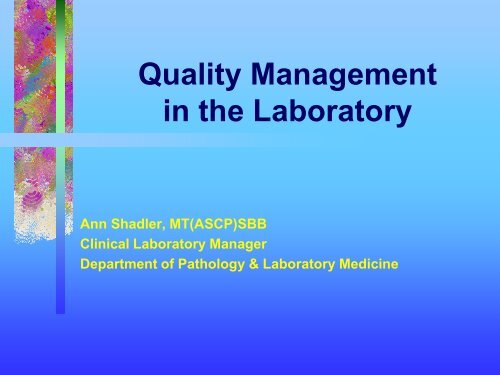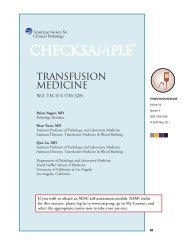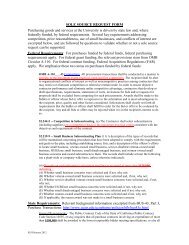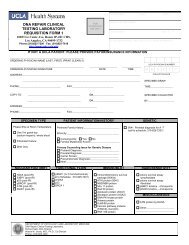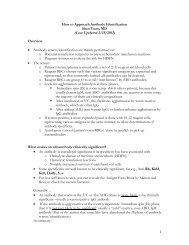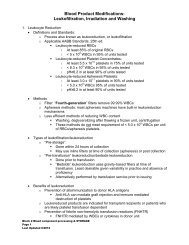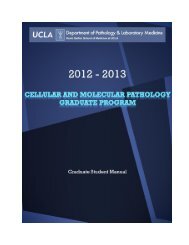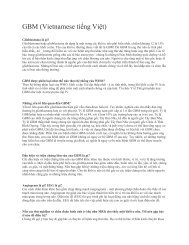Quality management in the laboratory - the UCLA Department of ...
Quality management in the laboratory - the UCLA Department of ...
Quality management in the laboratory - the UCLA Department of ...
- No tags were found...
You also want an ePaper? Increase the reach of your titles
YUMPU automatically turns print PDFs into web optimized ePapers that Google loves.
<strong>Quality</strong> Management<strong>in</strong> <strong>the</strong> LaboratoryAnn Shadler, MT(ASCP)SBBCl<strong>in</strong>ical Laboratory Manager<strong>Department</strong> <strong>of</strong> Pathology & Laboratory Medic<strong>in</strong>e
Learn<strong>in</strong>g Objectives• Def<strong>in</strong>e key elements <strong>of</strong> a documentedquality <strong>management</strong> system (QMS)• Describe <strong>the</strong> role <strong>of</strong> <strong>the</strong> <strong>laboratory</strong>director <strong>in</strong> develop<strong>in</strong>g, implement<strong>in</strong>gand oversee<strong>in</strong>g <strong>the</strong> program• Identify criteria that evaluate a QMS foreffectiveness
“<strong>Quality</strong>” Term<strong>in</strong>ology• <strong>Quality</strong>• <strong>Quality</strong> Control• <strong>Quality</strong> Assurance• <strong>Quality</strong> Indicator
More “<strong>Quality</strong>” Term<strong>in</strong>ology• <strong>Quality</strong> Improvement• <strong>Quality</strong> Management System• <strong>Quality</strong> ManagementGlossary <strong>of</strong> Commonly Used <strong>Quality</strong> Terms: Attachment pages 1-2
Progression <strong>of</strong> <strong>Quality</strong>• 1940s – 1960s: Laboratory qualitycontrol (QC)• 1970s: Pr<strong>of</strong>iciency Test<strong>in</strong>g• 1980s: <strong>Quality</strong> Assurance (QA)• 1990s: <strong>Quality</strong> Systems
History <strong>of</strong> <strong>the</strong> QMS• 1995 - FDA Guidel<strong>in</strong>e for <strong>Quality</strong> Assurance<strong>in</strong> Blood Establishments• AABB <strong>in</strong>corporated <strong>the</strong> quality <strong>management</strong>concepts <strong>in</strong>to its accreditation standards• 1999 -CLSI published guidel<strong>in</strong>e on QMconcepts• 2003 - ISO 15189, Medical Laboratoriespublished
Why have a QM Program?Enhances <strong>the</strong>se outcomes:• Ability to reduce or elim<strong>in</strong>ate medical error;• <strong>the</strong> likelihood <strong>of</strong> meet<strong>in</strong>g customerrequirements;• <strong>the</strong> potential for successful governmental andaccreditation assessments; and• susta<strong>in</strong>able atta<strong>in</strong>ment <strong>of</strong> quality objectives.
Regulatory Requirement• CLIA Regulations (§493.1200 - §493.1299)– Subpart K – <strong>Quality</strong> System for Non-Waived Test<strong>in</strong>g• CMS approves accredit<strong>in</strong>g organizations– CAP - COLA– AABB - TJC
Choos<strong>in</strong>g a QMS Framework• <strong>Quality</strong> System Essentials (QSE)• Similar elements described– AABB - CLIA– CAP - FDA– CLSI - ISO 15189
QSE Accord<strong>in</strong>g to CLSIDocument HS1-A2OrganizationPersonnelEquipmentSupplier IssuesProcess ControlFacilities / SafetyDocuments/RecordsIncidents / ErrorsAssessmentsProcess ImprovementCustomer ServiceInformation ManagementComponents <strong>of</strong> a QMS: Attachment pages 3-4
The <strong>Quality</strong> Manual• Def<strong>in</strong>es and documents <strong>the</strong> QMS• Tool for communicat<strong>in</strong>g operationalguidel<strong>in</strong>es to your staff and to externalassessors• Provides <strong>the</strong> opportunity for staff to see<strong>the</strong>ir <strong>in</strong>tegrated roles and responsibilities• <strong>Quality</strong> Manual TOC: Attachment page 5
<strong>Quality</strong> Management Plan• A document that describes <strong>the</strong> <strong>laboratory</strong>’soverall QM program• Includes a statement <strong>of</strong> <strong>the</strong> <strong>laboratory</strong>’scommitment to quality and patient safety• Spells out <strong>the</strong> types <strong>of</strong> monitor<strong>in</strong>g that will beperformed• Includes major planned quality improvementactivities• Specifies how quality and safety <strong>in</strong>formationis to be collected and dissem<strong>in</strong>ated
<strong>Quality</strong> Management Plan• Required by CAP (GEN.13806)• Provides reasonable assurance that <strong>the</strong><strong>laboratory</strong>– Complies with laws and regulations– Meets def<strong>in</strong>ed standards <strong>of</strong> <strong>laboratory</strong> practice– Engages <strong>in</strong> quality improvement activities• QM Plan and Program must be implemented!
Key Elements <strong>of</strong> a QM Program• Written <strong>Quality</strong> Manual <strong>in</strong>clud<strong>in</strong>g a QM Plan• Implementation• Data collection• Analyze and evaluate data• Identify opportunities for improvement• Implement improved processes• Evaluate improvements• Communicate results
Where can you get ideas forimprovement?• Incident reports• Internal assessments• Institutional goals, vision, and mission• Lean or Six Sigma processes• Customer feedback• Employee suggestions• Utilization reports
Monitor<strong>in</strong>g <strong>Quality</strong> Indicators• Select <strong>in</strong>dicators which monitor <strong>the</strong>quality <strong>of</strong> performance– Pre-analytic variables: specimensubmission and handl<strong>in</strong>g– Analytic variables: diagnostic accuracy– Post-analytic variables: report adequacyand <strong>in</strong>tegrity• <strong>UCLA</strong> <strong>Quality</strong> Indicators: Attachment pages 6-7
Act<strong>in</strong>g on <strong>Quality</strong> Indicator Data• identify<strong>in</strong>g opportunities for improvement;• implement<strong>in</strong>g corrective action;• perform<strong>in</strong>g a root cause analysis;• develop<strong>in</strong>g a quality improvement strategy;• modify<strong>in</strong>g targets or action thresholds;• report<strong>in</strong>g to <strong>in</strong>terested parties; and• decid<strong>in</strong>g to cont<strong>in</strong>ue monitor<strong>in</strong>g or stopmonitor<strong>in</strong>g <strong>the</strong> <strong>in</strong>dicator.
<strong>Quality</strong> System Internal Audits• Audits should be formally planned andorganized• Target operations that have <strong>the</strong> highest riskfor non-conformance and impact on patientcare• Tracer methodology audits• QSE: Organization self assessment: Attachment pages 8-9• NY Dept <strong>of</strong> Health tracer audit: Attachment 10-12
Management Review• The QMS shall <strong>in</strong>clude a <strong>management</strong>review– <strong>Quality</strong> <strong>in</strong>dicator data– <strong>Quality</strong> system audits– Pr<strong>of</strong>iciency test<strong>in</strong>g failures– Non conformities <strong>in</strong>clud<strong>in</strong>g compla<strong>in</strong>ts– Results <strong>of</strong> improvement processes– External <strong>in</strong>spection reports
Management Review• Are corrective actions implemented?– Are problems <strong>in</strong>vestigated?– Are potential solutions discussed/evaluated?– Are changes <strong>in</strong>stituted?– Are changes evaluated for effectiveness?• QMS review activities must bedocumented
Evaluat<strong>in</strong>g Your QM Program1. Is <strong>the</strong> QM program comprehensive?2. Is <strong>the</strong> plan implemented as written?3. Is data analyzed?4. Are corrective actions implemented?5. How are improvements evaluated?6. How and to whom are resultscommunicated?
Laboratory Director’sResponsibilities (CLIA)• The <strong>laboratory</strong> director is responsiblefor <strong>the</strong> overall operation andadm<strong>in</strong>istration <strong>of</strong> <strong>the</strong> <strong>laboratory</strong>… andfor assur<strong>in</strong>g compliance with <strong>the</strong>applicable regulations (CLIA “88)• 14 items: Attachment page 13
Lab Director’s Role <strong>in</strong> aQM Program• Development• Ensur<strong>in</strong>g implementation• Assessment and reassessment <strong>of</strong> activities• Monitor<strong>in</strong>g improvements• Communication• Ensur<strong>in</strong>g <strong>in</strong>tegration with <strong>in</strong>stitution’s program• Strategic and proactive guidance
QM Suggestions for <strong>the</strong>Laboratory Director• Communicate importance <strong>of</strong> <strong>the</strong> QM program• Lead by example• Lead <strong>the</strong> QM meet<strong>in</strong>g• Communicate with staff regard<strong>in</strong>g changes• Encourage discussion <strong>of</strong> problems• Discuss unusual cases, aberrant results, etc.• Cover all shifts– Make rounds on even<strong>in</strong>g and night shifts
Key Po<strong>in</strong>ts for <strong>the</strong>Laboratory Director• Focus on those items that are– Mean<strong>in</strong>gful– Patient centered– Problematic– Risk reduc<strong>in</strong>g– Director driven– Reflective <strong>of</strong> a culture <strong>of</strong> quality• Be visible• Be <strong>in</strong>volved• Communicate
Summary• The quality <strong>management</strong> plan is a liv<strong>in</strong>gdocument and requires ongo<strong>in</strong>g review andimprovement• Active <strong>in</strong>volvement <strong>of</strong> <strong>the</strong> <strong>laboratory</strong> director<strong>in</strong> <strong>the</strong> QM program is key to provid<strong>in</strong>g qualitypatient care and ensur<strong>in</strong>g patient safety• Develop<strong>in</strong>g and follow<strong>in</strong>g a strategic planfocused on quality and service helps ensure<strong>the</strong> improvement <strong>of</strong> patient care and shouldbe a key component <strong>of</strong> <strong>the</strong> QM Program.
Resources• College <strong>of</strong> American Pathologists– <strong>Quality</strong> Management <strong>in</strong> Anatomic Pathology (2005)– <strong>Quality</strong> Management <strong>in</strong> Cl<strong>in</strong>ical Laboratories (2010)– CAP Laboratory General Checklist (6.17.2010)• Cl<strong>in</strong>ical and Laboratory Standards Institute– HS1-A2 A <strong>Quality</strong> Management System Model forHealth Care (2004)– GP26-A3 Application <strong>of</strong> a <strong>Quality</strong> System Modelfor Laboratory Services (2004)– GP22-A2 Cont<strong>in</strong>uous <strong>Quality</strong> Improvement (2004)
Pathology & Laboratory Medic<strong>in</strong>e<strong>Quality</strong> ManualLocated on <strong>the</strong> Pathology website at:http://www.<strong>in</strong>trapathnet.medsch.ucla.edu/Hosp_Compliance/QManual.php
Thank you


